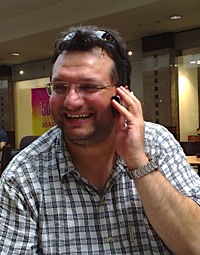Author: M. Fatih Taşar was born in Turkey where he earned a
B.S. and M.S. degree in physics and earned his Ph.D. in science education at
Pennsylvania State University. He was involved in recent curriculum reform
efforts in Turkey and has been a member of the committee of science curriculum
development for grades 4-8. He is
a professor of science education at Gazi Üniversitesi, Ankara and actively
involved in science teacher education and science education research.
The
sole authority in education in Turkey is the Ministry National of Education (MNE). MNE has offices in each province. Provinces are divided into smaller
township districts for administrative purposes. Hence, school principals are
responsible to township directors, who, in turn, are responsible to the
Minister of Education. Despite the recent efforts to share and distribute the
central power of the MNE to provincial directorates, currently all the
fundamental and strategic decision making, including staff recruitment and
dismissal, curricular issues, and opening new school buildings are made at the
MNE headquarters in Ankara. The eight years primary education is compulsory for
all and provided for free in public schools. A four year secondary education is
also free in public schools for anyone wishing to have further education.
With
the population of the country reaching 74 million in 2007 and continuing to
increase in the years ahead the number of children attending more than 34,600
primary schools is 10,847,000 according to recent statistics. A total of 3,400,000 students are enrolled in all sorts of different
secondary education schools. However, only 37% of them are enrolled in vocational and
technical secondary schools in a country where on the one hand there exists a
high unemployment rate for decades and on the other hand industry is often
complaining of inadequately qualified workers.
Science and Technology Education in Turkey
With the recent changes made in the
curriculum a course titled ‘Science and Technology’ is offered in grades 4-8. A
notable feature of the new curriculum is that technology education is now being
integrated into science education and in this way sharing the higher status of
the science course. Formerly, there existed a course named ‘Work-Technique’ for
boys and another named ‘Home Economics’ for girls. In the new curricula there
is now a separate course named ‘Technology and Design’.
The new primary science and technology curriculum has many characteristics: it has seven learning areas with four content strands supported by skills, understanding and attitudes; there is a spiral approach for each strand; mainly based on the constructivist approach; enriched with teaching activities and multiple assessment methods and techniques. The Seven Learning Areas are the following:
- Physical
Processes
- Life and Living
Beings
- Matter and Change
- The Earth and the
Universe
- Science Process
Skills (SPS)
- Science-Technology-Society-Environment
(STSE)
- Attitudes and Values (AV)
While
the first four of these represent the content areas, the remaining three are
interwoven into them throughout the grades. Although, they are not included as
separate units they are visible in all content area units. This approach
clearly indicates the intent of having pupils engaged in student-centered
activities while learning the content. Learning by doing is seen to be a
central pillar of the new curriculum.
The structure of the curriculum is established so that students may bring their daily life experiences into classrooms and, conversely, can take out their school experiences outside the school. In order to realize this, several suggested activities are provided in order to incorporate many related curricular outcomes to technology understandings.
The new curriculum, where appropriate, prompts teachers to such important student misconceptions identified in the literature. Another purpose is to alert teachers to those wide spread misconceptions since often times the teachers may have persistent misconceptions themselves.
The new curriculum urges teachers and educators to use more formative learning assessment and measurement techniques rather than usual paper and pencil tests. Among the many alternative measurement methods and techniques that can be listed, the range includes developing a student portfolio, group activities, and peer evaluation.
Change in the name of the course
Traditionally the science courses in primary education had been named “science knowledge.” The curriculum development committee felt this name didn’t include the various aspects of science and that it misled students in that science is made up of only theories. In order to make the curriculum reform more meaningful, a name change was considered and the course is now named “science and technology”.
The units in the content strands
As mentioned above there are four content areas. Each one has several units folding out as the years progress. The spiral character of the curriculum is also evident from this table.
Weekly course hours
Another big improvement was made in the weekly course hours with the new curriculum. Science courses in grades 4-8 were given 3 class hours per week, but with the current reform efforts the weekly hours were increased to 4 class hours per week. Currently, in grades 4-8 pupils take 144 class hours of the science and technology course in each grade. Here we should also mention that there is a separate course entitled “design and technology” that is similar to the science and technology class, which is two hours per week.
In Turkey one school year is two semesters of 18 weeks each. The school year and first semester usually starts in mid-September and classes end for that semester around the end of January. After a two week holiday, classes resume again in mid-February and the school year and second semester ends in mid-June. Teachers have a paid two-week seminar both before classes begin in September and after classes end in June. These seminars are meant to give teachers preparation time. Each curricular department makes their arrangements for their yearly activities in this period, as well.
Turkish secondary science curricula
There are different types of high schools in Turkey and the popular ones accept students by an entry examination. Among them the so called ‘Science’ and ‘Anatolian’ high schools have greater success rates in the university selection and placement examinations. The majority of high school students are enrolled in ‘general’ type high schools. There are four selection areas in the general and Anatolian type high schools for students to determine their future specialization: Science, social sciences, Turkish-Mathematics, and Foreign Languages. In the 9th grade students take common courses and in the subsequent grades the weight of the courses are determined according to areas of specialization. Thus, physics, chemistry, and biology are given 2 class hours per week in the 9th grade for all high school students. In grade 10 the students who select science as their specialization areas have these courses again 2 hours per week. In grades 11 and 12 the number of class hours is increased to 3 for these courses. Students in other specialization areas don’t take these science courses in upper grades but they can take them as electives if they wish to do so.
To monitor the quality of education given in schools and classrooms there exists an inspection system governed by the Ministry. Inspectors regularly visit classrooms and give suggestions and ratings for each teacher and school. These official reports are then submitted to their chiefs. There are five main categories of operation on which the inspectors grade the teachers: guidance and on-the-job training, inspection and evaluation, examination, investigation, and research. Teachers are also provided in-service development opportunities at seven dedicated institutions nation-wide operated by the MNE. The ministry often cooperates with university faculty members in designing and running short term courses (one or two week) for teachers and inspectors. An immense teacher development effort is being implemented throughout the country for the renewed primary curricula and its approach to teaching and learning.
Science teacher education in Turkey
Teacher training in Turkey is done in faculties of education. There are 67 faculties of education throughout the country and 46 of them have a science teaching program (for grades 6-8). Since 1992 a separate science teaching program was established for middle grades because the science courses in these grades include all sorts of science topics. It was thought that when teachers certified in physics, chemistry, or biology teach these courses they were more inclined to give emphasis to their own areas and often omit others. Hence, it was deemed that there was a severe need for teachers certified to teach multiple science topics.
In Turkey the usual practice is that a classroom teacher takes a class from grade 1 and teaches them for 5 years until the end of grade 5. This places a large responsibility on classroom teachers as these general education teachers are responsible for the scientific education of their pupils. A resolution to this is being discussed is if it would be better to have science teachers teach 4th and 5th science courses instead of classroom teachers.
Prospective primary teachers attend 4-year university programs in Turkey. Prospective teachers of secondary education attend 5-year programs in faculties of education. Also, graduates of faculties of arts and sciences can attend a masters program (3 semesters) offered by faculties of education in order to become eligible for teaching. All the prospective teachers have to pass a qualifying exam before getting employed by the MNE. Although most universities have masters programs in education currently there are only 9 universities offering PhD degrees in science education in Turkey.
The problems to solve
Currently, Turkey has not yet achieved a 100% schooling and literacy. Also, there is a teacher deficit mainly in primary grades, although there is no shortage of teacher supply. Another area that needs improvement is the large class sizes especially in the cities. Decentralization, a research oriented approach to problems, and government investment together with the encouragement and utilization of private investment in the area of education will prove helpful and effective.


